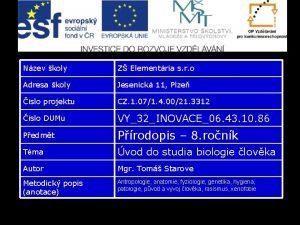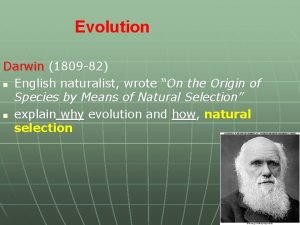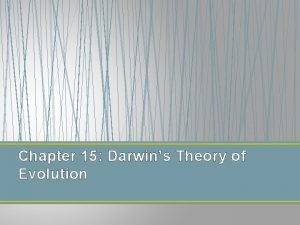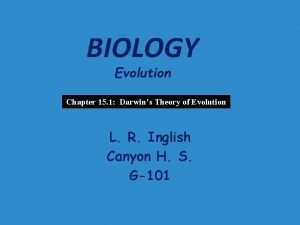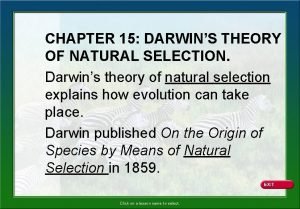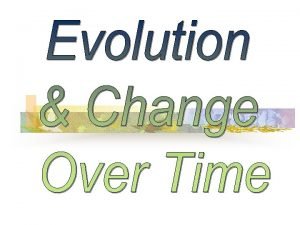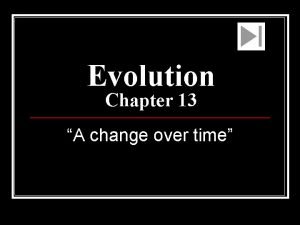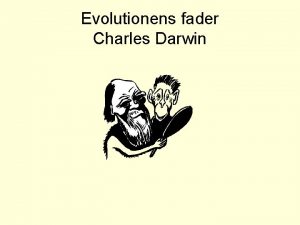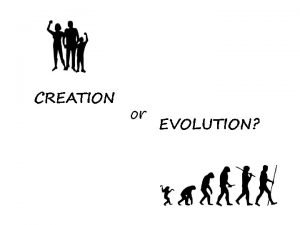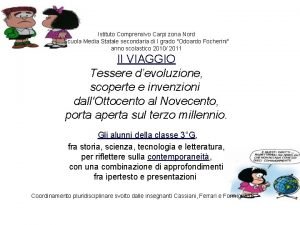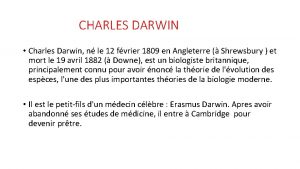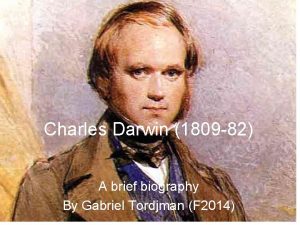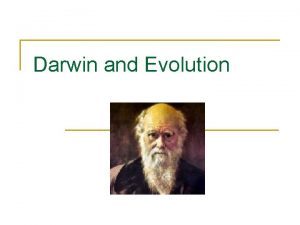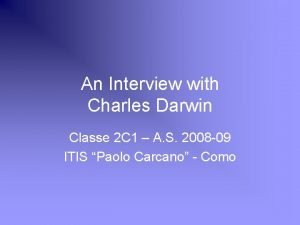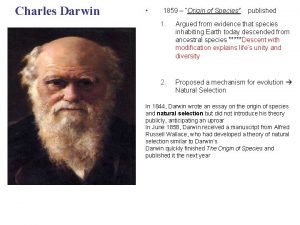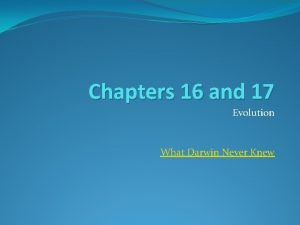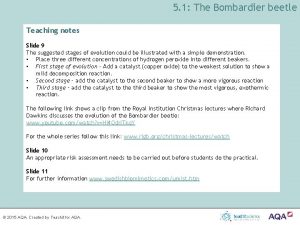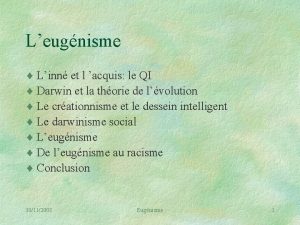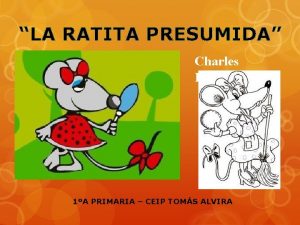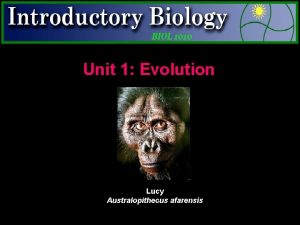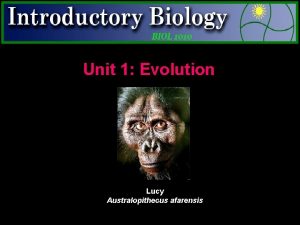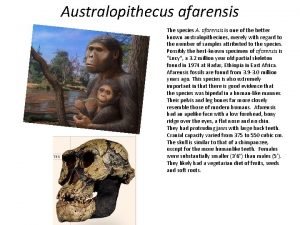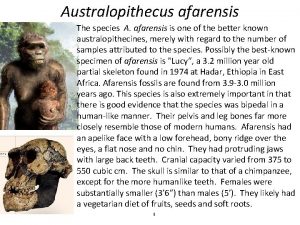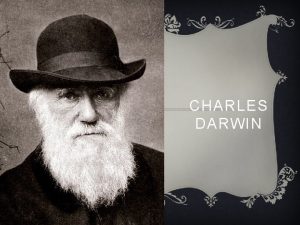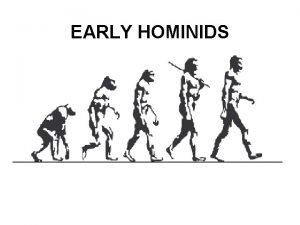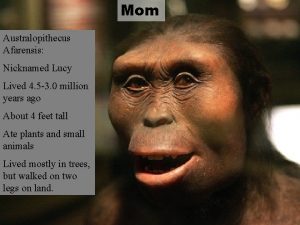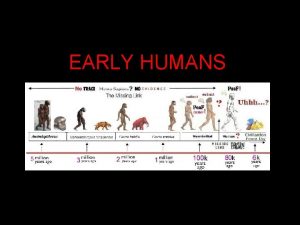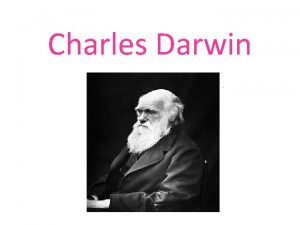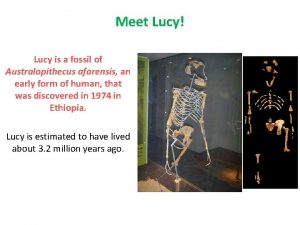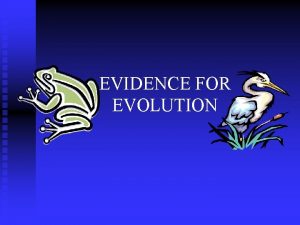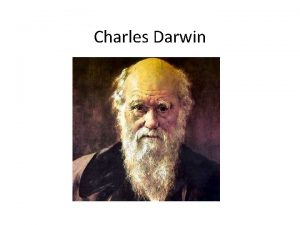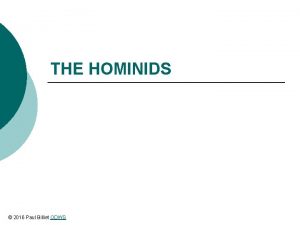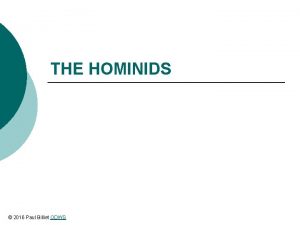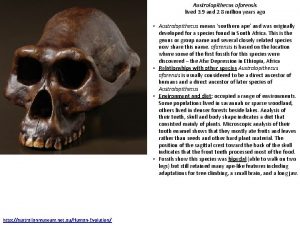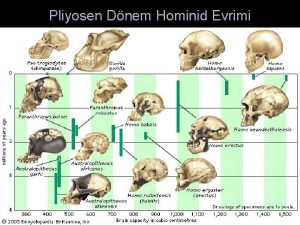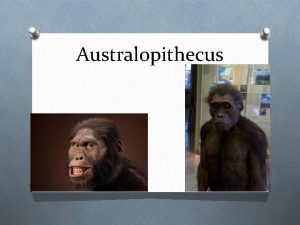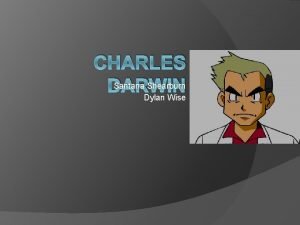Unit 1 Evolution Lucy Australopithecus afarensis Charles Darwin



























- Slides: 27

Unit 1: Evolution Lucy Australopithecus afarensis

Charles Darwin 1859


Process of Experimental Discovery • Information and ideas turn into concepts • Concepts lead to experiments • Data is collected leading to an enhanced knowledge base • Knowledge leads to discovery • Hypotheses are developed • More experiments approaching from different angles • More knowledge coalesces into a theory • More experiments, more data • Ultimately true understanding is achieved and your theory becomes accepted scientific fact Truth is based on the degree you wish to accept the outcome of scientific discovery. Evolution does not deny the existence of a higher being. It attempts to explain our accumulation of knowledge as to how life could have arisen on earth and the course of life progression & life diversity from the simplest to the complex. In his time Darwin was a very religious man. It troubled him that his theory of competition and natural selection was fought by religious leaders & followers.


How did life arise?

Ingredients for the Origin of Life 1. Basic elements & basic organic compounds 2. Complex biomolecule(s) capable of replication 3. A membrane enclosure 4. Selection & evolutionary change

Formation of the elements in stars • PBS Video link. click “Watch the program”. locate at the bottom of a movie window a green frame slider. move it to the right to about a 37 minute point (may have to wait through commercials) Local copy

Were building blocks of life present? 1. All elements are forged in the interior of stars – when a star explodes in a supernova elements blasted into space. 2. Many carbon-based molecules including CN, CH 3, CO 2, amino acids, and precursors of nucleotides brought to Earth by asteroids & comets. 3. Early oceans were a chemical factory for rich array of organic molecules.

Most Common Elements in Living Organisms carbon (C) oxygen (O) hydrogen (H) nitrogen (N) calcium (Ca) phosphorus (P) potassium (K) sulfur (S)

Formation of Solar System, Earth & Life • Our solar system formed about ____ years ago. 4. 5 -4. 6 BYA • The Earth’s surface had cooled sufficiently for oceans to form by ~ _____ years ago. 4. 0 BYA • The first fossil evidence of life is about _____ years old. 3. 7 -3. 8 BY

Stanley Miller Experiments • 1953, 23 year old Stanley Miller sets up an experiment to mimic early Earth environment in a flask. The flask contained water vapor, H 2, CH 4, and NH 3. For energy he used heat and a sparking device to mimic lightning. After a week, he found specific organic compounds, amino acids, the building blocks for proteins.

15. 2 SCIENTIFIC DISCOVERY: Experiments show that the abiotic synthesis of organic molecules is possible § After a week, Miller’s setup produced abundant amino acids and other organic molecules. • Similar experiments used other atmospheres and other energy sources, with similar results. • Stage 1, abiotic synthesis of organic molecules, was demonstrated to be possible by the Miller-Urey experiments. © 2012 Pearson Education, Inc.

Organic Compounds Hydrogen & other elements covalently bond to carbon to form: • Carbohydrates • Lipids • Proteins • Nucleic Acids

15. 3 Stages in the origin of the first cells probably included the formation of polymers, protocells, and self-replicating RNA • Stage 2: The joining of monomers into polymers – Hot sand, clay, or rock may have helped monomers combine to form polymers. – Waves may have splashed organic molecules onto fresh lava or other hot rocks and then rinsed polypeptides and other polymers back into the sea. © 2012 Pearson Education, Inc.

15. 3 Stages in the origin of the first cells probably included the formation of polymers, protocells, and self-replicating RNA § Stage 3: Packaging of polymers into protocells • Small membrane-bounded sacs or vesicles form when lipids are mixed with water. • These abiotically created vesicles are able to grow and divide (reproduce). © 2012 Pearson Education, Inc.

15. 3 Stages in the origin of the first cells probably included the formation of polymers, protocells, and self-replicating RNA § Stage 4: The origin of self-replicating molecules • Today’s cells transfer genetic information from DNA to RNA to protein assembly. However, RNA molecules can assemble spontaneously from RNA monomers. • RNA monomers in the presence of RNA molecules form new RNA molecules complementary to parts of the starting RNA. • Some RNA molecules, called ribozymes, can carry out enzymelike functions. © 2012 Pearson Education, Inc.

Was RNA the original self replicating molecule? • Ancient viruses use RNA as genetic material, not DNA. Some are still common such as influenza and hepatitis C. • Further evidence lies in diverse role of RNA in all modern cells and discovery of catalytic functions. • Only RNA can initiate DNA replication. A bacterial ribosome: Green = protein Blue = RNA • RNA regulates gene expression, repairs genes, carries genetic information from DNA to ribosomes. • Ribosome, an ancient molecular complex that assembles proteins is made of RNA + protein. The RNA is part of the catalytic site for peptide bond formation.

“chicken & egg problem” for the origin of life: “DNA needed to make proteins but proteins needed to make DNA” • Proteins known as enzymes catalyze reactions essential to cell's survival • Proteins were thought to be the only biological molecules capable of catalysis. • Ribozymes: Catalytic functions discovered • Altman & Cech (1982) discovered RNAs can act as catalysts for chemical reactions. These catalytic RNAs are known as ribozymes • Certain ribozymes called RNA replicases were also The Hammerhead Ribozyme found to catalyze their own synthesis

RNA World G C • All these lines of evidence suggest use of RNA by early life forms for genes AND replication preceded proteins and DNA • Later more stable and efficient molecules such as DNA and proteins evolved and replaced much of RNA’s functionality • In 1986 Harvard biologist Walter Gilbert called this idea the RNA World hypothesis T A RNA World Proto-cell

Lipid Bilayer • Natural bilayers are made of phospholipids having a hydrophilic head & 2 hydrophobic tails. • When exposed to H 2 O spontaneously form a two-layered sheet with tails pointing toward the center • The cell membranes of all living organism are made of a lipid bilayer, as are membranes surrounding nucleus & other sub-cellular structures.

Formation of the Protocell • Self-assembly of Membrane • Permeability of Membrane • Division of the Proto-cell

Animation of protocell division • http: //exploringorigins. org/protocells. html • This brings us to the site and we want to look at the animation entitled “A protocell life cycle featuring RNA replication and vesicle growth. ”

How do protocells evolve? • Protocells encapsulated with higher RNA content outcompete protocells with no or little RNA – They may grow by stealing membrane • RNA’s must be replicases and mutation rate will generate better versions and enhance competition with other protocells • Merging with other protocells can bring RNA with other capabilities into the protocell

Natural selection would take hold on these protocells • The protocells containing ribozymes that replicated efficiently would grow more efficiently and ‘reproduce’ • This trait would then be passed onto future generations • Replication errors or mutations would result in additional variation which is the way natural section works • Eventually, DNA would be selected for as the genetic material

Proto-Cell Competition & Evolution • Replication of RNA molecules within protocell creates osmotic gradient • Cell membrane stretches - grabs fatty acids from membranes of cells with lower RNA replication rates & hence lower osmotic gradients • Via this process cells with higher rates of RNA synthesis divide & grow faster than other cell types – eventually outcompete and take over • Competitive vesicle growth could have played role in emergence of Darwinian evolution at one gene-one cell level

Creation of artificial life • PBS Video link – Click “Launch video” button Local copy
 Australopithecus lucy
Australopithecus lucy Charles darwin theory of evolution
Charles darwin theory of evolution H
H Chapter 15 darwin's theory of evolution
Chapter 15 darwin's theory of evolution Chapter 17 darwins theory of evolution
Chapter 17 darwins theory of evolution Chapter 15 darwin's theory of evolution section 15-1
Chapter 15 darwin's theory of evolution section 15-1 Homologous structures definition biology
Homologous structures definition biology Chapter 15 darwin's theory of evolution
Chapter 15 darwin's theory of evolution Homologous structures example
Homologous structures example Darwin's theory of evolution
Darwin's theory of evolution Vem var charles darwin
Vem var charles darwin Worldview academy
Worldview academy Where was charles darwin born
Where was charles darwin born Interpersonal intelligence famous people
Interpersonal intelligence famous people Charles darwin origine della specie
Charles darwin origine della specie Charles darwin origine della specie
Charles darwin origine della specie Charles darwin vikidia
Charles darwin vikidia Where was charles darwin born
Where was charles darwin born Charles darwin notes
Charles darwin notes Chronemics communication definition
Chronemics communication definition Charles darwin
Charles darwin Darwin
Darwin Origin
Origin Charles darwin
Charles darwin Bombardier beetle darwin
Bombardier beetle darwin Darwin and lamarck venn diagram
Darwin and lamarck venn diagram Qi de darwin
Qi de darwin La ratita presumida charles perrault
La ratita presumida charles perrault
